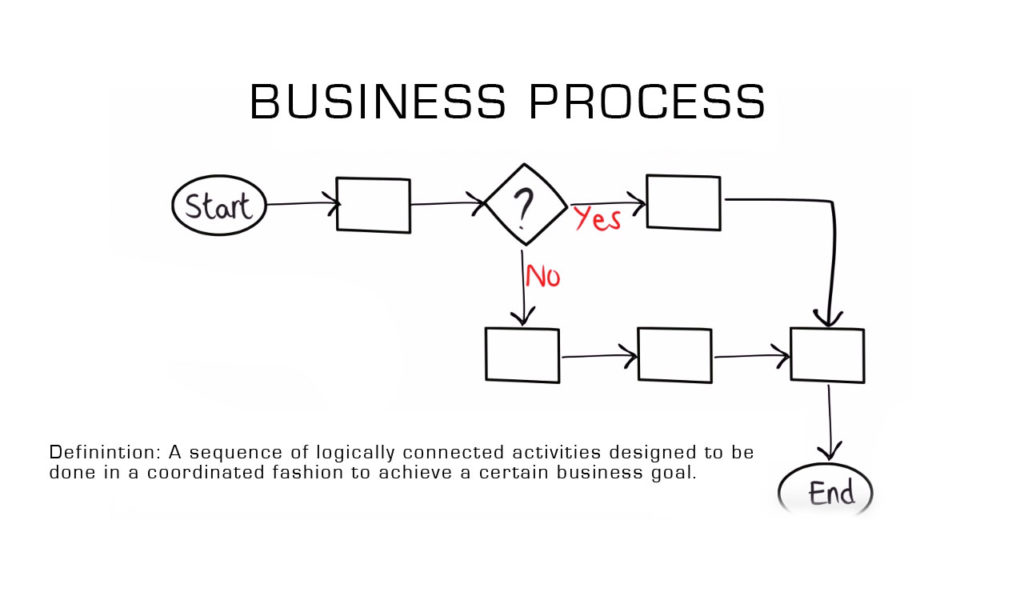“The entrepreneur’s job is to create the process, management’s job is to make sure the process is followed, and the technician’s job is to use the process.” –Michael Gerber
To create a successful business, it takes a lot of parts coming together nicely to provide a good product or service. However, one common denominator that all great businesses have is effective business processes.
What is a business process?
A business process is a sequence of logically connected activities designed to be done in a coordinated fashion to achieve a certain business goal. In other words, a business process is a series of activities or steps designed to create something of value.
To create a business process, you break-down the job of creating value into logical chunks of activities that each individual can do according to their skill set. The business process may be displayed as a workflow chart, a flowchart, or a written series of steps.

Two types of processes
- Instructional Processes: These processes are designed to instruct a team member how to do something or what to do. This includes directions, recipes, instructions, and standards for how to complete specific tasks. It covers rules or controls for increasing quality and reducing financial risks. Through good instructional processes, management speaks to the employees, telling them what to do, who is going to do it, when, where, and how to do it. Good instructional processes include why each step of the process is important.
- Reporting Processes: These processes are designed to help employees in a timely manner to collect reliable data or feedback to provide the leadership so they can quickly make decisions to improve the business.
Why do we need business processes?
- Company Map: Maps your business and shows you what it takes to run your company.
- Standardization and Consistency: Good processes produce standardization, consistency, and reliability. At the same time, it reduces risks and variance.
- Business Improvement: When a business wants to get better, a key place to look at is their processes. They look to see weaknesses in the processes and how those can be improved. Facilitates Business Improvement.
- Delegation: Good business processes make it easier to delegate tasks.
- Quality: Increases the probability that delegated tasks will be done as intended.
- Onboarding: Good processes make it easy to train new people.
An ongoing process
Writing and implementing business processes is never complete. It’s not a one-time event but an ongoing process of improving the processes that have been written, keeping them up to date, and writing new ones as they become necessary. As the business grows and needs to perform new tasks, it will need new processes to make sure that excellent quality products are being delivered in a timely fashion without much risk involved.
*Deciding what processes to put in place and deciding how many of them is a challenge that many entrepreneurs face.
The Process Creation & Implementation Team
Who should lead the process of creating business processes? The entrepreneur or a proven senior leader. For a small company, entrepreneurs should avoid delegating leadership in this area to a new, unproven leader.
Who should actually write the business process? In his fascinating book, Grow to Greatness, Dr. Edward Hess, says many entrepreneurs stress that “the development and writing of processes should be part of an employee’s job; everyone should create a process that someone else could follow when the employee was absent because of illness or vacation.” When done correctly and reviewed by upper-level, Hess says, “the business achieves the goal of ‘not having a single point of failure.’ The entrepreneurs he studied said, “embedding the development and improvement of business processes into each employee’s job description ‘collectivizes problems’ and empowers line employees to think about how to constantly improve.”
In our businesses and corporations, both profit and nonprofit, each employee takes charge of writing and updating the processes that they perform and also take the responsibility of scheduling a quarterly or biannual meeting with their supervisor to review their processes.
While key leaders should lead and supervise the “business process” writing process, and the employee performing the tasks should write and keep the process updated, all key team members should be involved.
In his research, Dr. Hess found that “Successful entrepreneurs prioritized what they needed to know and what processes were necessary to acquire and maintain happy customers. They trained employees to do multiple jobs, measured and rewarded the right behaviors, posted daily production or customer service data so all employees knew how the business was doing and created a culture of high performance.”
Related Topics
- Process-Mapping or Process Modeling, e.g. See this video.
- Business-Process Reengineering.
- Business Process Managment.
Helpful Resources
- Michael Gerber, “The E-Myth Revisited: Why Most Small Businesses Don’t Work and What to Do About It”
- Edward Hess, “Grow to Greatness: Smart Growth for Entrepreneurial Businesses”
- http://theprocessconsultant.com/business-process-consulting/ Accessed 03/03/2017
- http://searchcio.techtarget.com/definition/business-process
- http://www.wikihow.com/Write-a-Business-Process-Document
- http://klariti.com/business-process/how-to-write-business-process/
